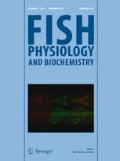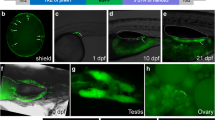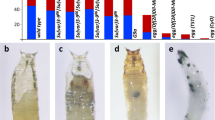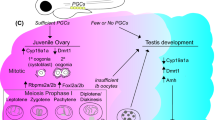Abstract
HIRA is one of the chaperones of histone H3.3. Mutation of Hira results in embryonic lethality in mice, suggesting a critical role in embryogenesis. However, Hira-mutated Drosophila may survive to adults, indicating that it is dispensable in Drosophila development. The role of Hira in fish development is unknown. In this study we first investigated the expression of Hira during embryogenesis of gibel carp (Carassius auratus gibelio) by whole-mount in situ hybridization. We found that Hira signal appeared ubiquitously in the early embryos. After gastrulation, it appeared mainly along the anterior–posterior axis, including the tail bud. In hatching period, the signal was detected in head, heart, and the endoderm region on the back of yolk. Then by microinjection with morpholino-HIRA at the beginning of development, we observed delayed gastrulation and abnormal somitogenesis in gibel carp embryos. The HIRA morphants exhibited short trunk, limited yolk extension, and twisted tail. Most of the mutants died during embryogenesis or shortly after hatching. The rest of the HIRA morphants could survive to larvae but with severe defects in organogenesis. These data suggest that HIRA may be essential for the development of gibel carp, and this function is conserved in vertebrates.





Similar content being viewed by others
References
Anderson HE, Wardle J, Korkut SV, Murton HE, López-Maury L, Bähler J, Whitehall SK (2009) The fission yeast HIRA histone chaperone is required for promoter silencing and the suppression of cryptic antisense transcripts. Mol Cell Biol 29:5158–5167
Bonnefoy E, Orsi GA, Couble P, Loppin B (2007) The essential role of Drosophila HIRA for de novo assembly of paternal chromatin at fertilization. PLoS Genet 3:1991–2006
Dimova D, Nackerdien Z, Furgeson S, Eguchi S, Osley MA (1999) A role for transcriptional repressors in targeting the yeast Swi/Snf complex. Mol Cell 4:75–83
Du XZ, Zhou L, Zhao HB, Wang YF, Gui JF (2008) Identical sequences but different expression patterns of Hira gene in gynogenetic and gonochoristic crucian carps. Fish Physiol Biochem 34:175–184
Gilbert SF (2009) Developmental Biology, 9th edn. Sinauer Associates, Sunderland
Gui JF, Zhou L (2010) Genetic basis and breeding application of clonal diversity and dual reproduction modes in polyploid Carassius auratus gibelio. Sci China Life Sci 53:409–415
Guo QH, Zhao ZK, Wang YF, Gui JF (2010) Expression analysis of Hira mRNA and protein during oogenesis in gynogenetic and gonochoristic crucian carps. Acta Hydrobiol Sin 34:611–617
Hajkova P, Ancelin K, Waldmann T, Lacoste N, Lange UC, Cesari F, Lee C, Almouzni G, Schneider R, Surani MA (2008) Chromatin dynamics during epigenetic reprogramming in the mouse germ line. Nature 452:877–881
Halford S, Wadey R, Roberts C, Daw SCM, Whiting JA, O’Donnell H, Dunham I, Bentley D, Lindsay E, Baldini A, Francis F, Lehrach H, Williamson R, Wilson DI, Goodship J, Cross I, Burn J, Scambler PJ (1993) Isolation of a putative transcriptional regulator from the region of 22q11 deleted in DiGeorge syndrome, shprintzen syndrome and familial congenital heart disease. Hum Mol Genet 2:2099–2107
Kirov N, Shtilbans A, Rushlow C (1998) Isolation and characterization of a new gene encoding a member of the HIRA family of proteins from Drosophila melanogaster. Gene 212:323–332
Konev AY, Tribus M, Park SY, Podhraski V, Lim CY, Emelyanov AV, Vershilova E, Pirrotta V, Kadonaga JT, Lusser A, Fyodorov DV (2007) CHD1 motor protein is required for deposition of histone variant H3.3 into chromatin in vivo. Science 317:1087–1090
Lamour V, Lecluse Y, Desmaze C, Spector M, Bodescot M, Aurias A, Osley MA, Lipinski M (1995) A human homolog of the S. cerevisiae HIR1 and HIR2 transcriptional repressors cloned from the DiGeorge syndrome critical region. Hum Mol Genet 4:791–799
Llevadot R, Marques G, Pritchard M, Estivill X, Ferrus A, Scambler P (1998) Cloning, chromosome mapping and expression analysis of the HIRA gene from Drosophila melanogaster. Biochem Biophys Res Commun 249:486–491
Loppin B, Docquier M, Bonneton F, Couble P (2000) The maternal effect mutation sesame affects the formation of the male pronucleus in Drosophila melanogaster. Dev Biol 222:392–404
Loppin B, Bonnefoy E, Anselme C, Laurençon A, Karr TL, Couble P (2005) The histone H3.3 chaperone HIRA is essential for chromatin assembly in the male pronucleus. Nature 437:1386–1390
Nakayama T, Shimojima T, Hirose S (2012) The PBAP remodeling complex is required for histone H3.3 replacement at chromatin boundaries and for boundary functions. Development 139:4582–4590
Phelps-Durr TL, Thomas J, Vahab P, Timmermans MC (2005) Maize rough sheath2 and its Arabidopsis orthologue ASYMMETRIC LEAVES1 interact with HIRA, a predicted histone chaperone, to maintain knox gene silencing and determinacy during organogenesis. Plant Cell 17:2886–2898
Ray-Gallet D, Quivy JP, Scamps C, Martini EM, Lipinski M, Almouzni G (2002) HIRA is critical for a nucleosome assembly pathway independent of DNA synthesis. Mol Cell 9:1091–1100
Ray-Gallet D, Woolfe A, Vassias I, Pellentz C, Lacoste N, Puri A, Schultz DC, Pchelintsev NA, Adams PD, Jansen LE, Almouzni G (2011) Dynamics of histone H3 deposition in vivo reveal a nucleosome gap-filling mechanism for H3.3 to maintain chromatin integrity. Mol Cell 44:928–941
Roberts C, Daw SCM, Halford S, Scambler PJ (1997) Cloning and developmental expression analysis of chick Hira (Chira), a candidate gene for DiGeorge syndrome. Hum Mol Genet 6:237–245
Roberts C, Sutherland HF, Farmer H, Kimber W, Halford S, Carey A, Brickman JM, Wynshaw-Boris A, Scambler PJ (2002) Targeted mutagenesis of the Hira gene results in gastrulation defects and patterning abnormalities of mesoendodermal derivatives prior to early embryonic lethality. Mol Cell Biol 22:2318–2328
Scambler PJ (1994) DiGeorge syndrome and related birth defects. Sem Dev Biol 5:303–310
Schneiderman JI, Orsi GA, Hughes KT, Loppin B, Ahmad K (2012) Nucleosome-depleted chromatin gaps recruit assembly factors for the H3.3 histone variant. Proc Natl Acad Sci USA 109(48):19721–19726
Sharp JA, Fouts ET, Krawitz DC, Kaufman PD (2001) Yeast histone deposition protein Asf1p requires Hir proteins and PCNA for heterochromatic silencing. Curr Biol 11:373–463
Sherwood PW, Osley MA (1991) Histone regulatory (hir) mutations suppress delta insertion alleles in Saccharomyces cerevisiae. Genetics 128:729–738
Song TY, Yang JH, Park JY, Song Y, Han JW, Youn HD, Cho EJ (2012) The role of histone chaperones in osteoblastic differentiation of C2C12 myoblasts. Biochem Biophys Res Commun 423:726–732
Szenker E, Lacoste N, Almouzni G (2012) A developmental requirement for HIRA-dependent H3.3 deposition revealed at gastrulation in Xenopus. Cell Rep 1:730–740
Tagami H, Ray-Gallet D, Almouzni G, Nakatani Y (2004) Histone H3.1 and H3.3 complexes mediate nucleosome assembly pathways dependent or independent of DNA synthesis. Cell 116:51–61
Wang Y, Zhou L, Li Z, Gui JF (2008) Molecular cloning and expression characterization of ApoC-I in the orange-spotted grouper. Fish Physiol Biochem 34:339–348
Wilming LG, Snoeren CA, van Rijswijk A, Grosveld F, Meijers C (1997) The murine homologue of HIRA, a DiGeorge syndrome candidate gene, is expressed in embryonic structures affected in human CATCH22 patients. Hum Mol Genet 6:247–258
Yang JH, Song Y, Seol JH, Park JY, Yang YJ, Han JW, Youn HD, Cho EJ (2011) Myogenic transcriptional activation of MyoD mediated by replication-independent histone deposition. Proc Natl Acad Sci USA 108:85–90
Zhang R, Poustovoitov MV, Ye X, Santos HA, Chen W, Daganzo SM, Erzberger JP, Serebriiskii IG, Canutescu AA, Dunbrack RL, Pehrson JR, Berger JM, Kaufman PD, Adams PD (2005) Formation of MacroH2A-containing senescence-associated heterochromatin foci and senescence driven by ASF1a and HIRA. Dev Cell 8:19–30
Zhao ZK, Wang YF (2010) The function of histone chaperones during development. Heredity (Beijing) 32:41–48
Zhao ZK, Li W, Wang MY, Zhou L, Wang JL, Wang YF (2011) The role of HIRA and maternal histones in sperm nucleus decondensation in the gibel carp and color crucian carp. Mol Reprod Dev 78:139–147
Zheng Y, Ren PP, Wang JL, Wang YF (2011) Wolbachia-induced cytoplasmic incompatibility is associated with decreased Hira expression in male Drosophila. PLoS ONE 6:e19512
Zhou L, Wan YF, Gui JF (2008) Preparation of polyclonal antibody and analysis of spatial expression of HIRA protein in gibel carp. Acta Hydrobiol Sin 32:354–359
Acknowledgments
We thank Prof. Gui JF of the Institute of Hydrobiology, Chinese Academy of Sciences, for kind help with the fish samples, confocal images, and microinjection. This work was supported by the National Nature Science Foundation of China (30671609).
Author information
Authors and Affiliations
Corresponding author
Additional information
Meng-Yu Wang and Qiu-Hong Guo have contributed equally to this work.
Rights and permissions
About this article
Cite this article
Wang, MY., Guo, QH., Du, XZ. et al. HIRA is essential for the development of gibel carp. Fish Physiol Biochem 40, 235–244 (2014). https://doi.org/10.1007/s10695-013-9839-x
Received:
Accepted:
Published:
Issue Date:
DOI: https://doi.org/10.1007/s10695-013-9839-x




